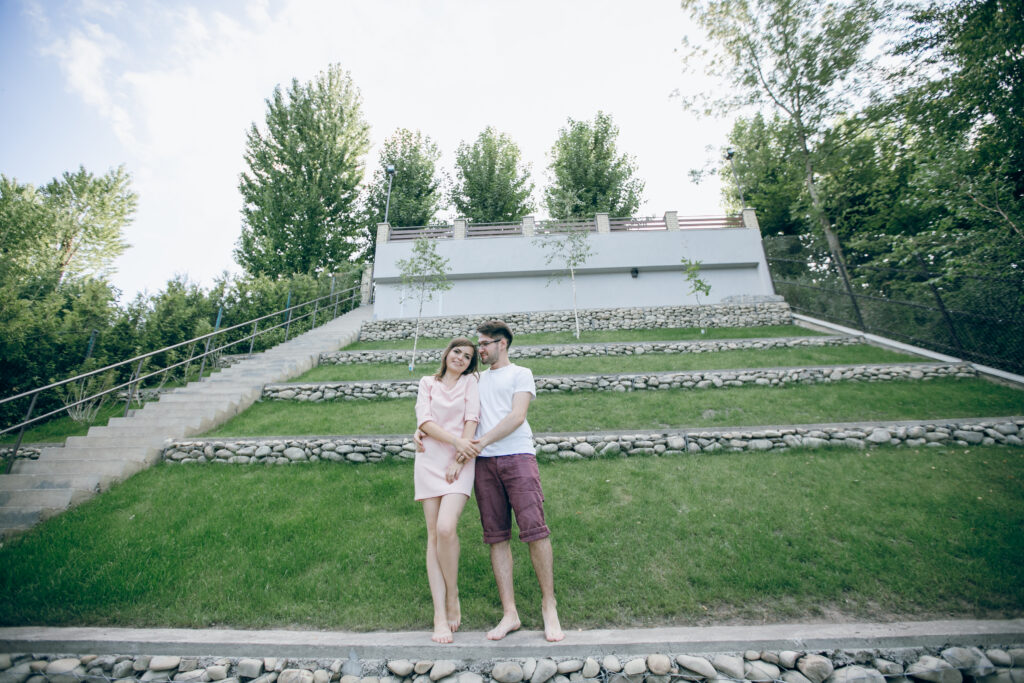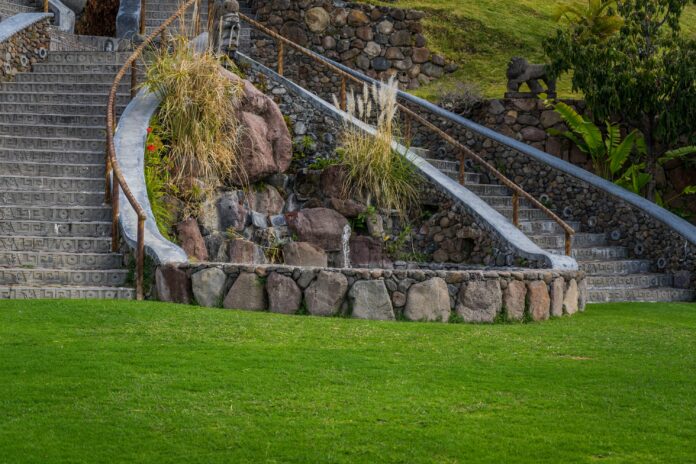Introduction
Creating a balanced and beautiful outdoor space often involves combining hardscaping vs. softscaping elements to achieve both structure and aesthetic appeal. In landscape design types, hardscaping includes non-living features like patios, pathways, and retaining walls, which provide durability and functionality. Meanwhile, softscaping involves living elements such as trees, shrubs, and flowers, adding color, texture, and vibrancy to the landscape. By understanding the unique characteristics of each, you can create a harmonious blend of elements that enhance both the look and functionality of your outdoor area.
Hardscaping vs Softscaping: Understanding the Core Elements

In landscape design, hardscaping vs softscaping refers to the balance between the structural, non-living elements and the natural, living elements that bring a space to life. Hardscaping includes items such as stone pathways, patios, retaining walls, and fountains. These elements add form, durability, and functionality to an outdoor area, giving structure and creating defined spaces.
What is Hardscaping?
Hardscaping refers to the solid, non-living elements in landscaping design. These typically include structures, pathways, water features, and other permanent elements that add shape and structure to the outdoor space.
Key Elements of Hardscaping
- Pathways and Walkways: Pathways provide structure, guide movement, and connect different areas within the yard. Materials like gravel, stone, and concrete are popular for creating durable pathways.
- Patios and Decks: Adding a deck and patio increases usable outdoor space, offering areas for dining, entertaining, or relaxation.
- Retaining Walls: Used to manage slopes or add dimension, retaining walls can also provide seating, prevent soil erosion, and define different zones.
- Water Features: Ponds, fountains, or waterfalls can bring a calming element, creating a focal point and adding texture to your yard.
Advantages of Hardscaping
- Low Maintenance: Unlike plants, hardscaping elements require minimal upkeep, saving time and reducing costs in the long run.
- Durability and Structure: Hardscaping creates a foundation for the landscape, providing long-lasting support and functionality.
- Enhanced Usability: Features like patios and walkways increase the functional space in your yard, making it more enjoyable and accessible.
What is Softscaping?
Softscaping includes the living aspects of landscaping. This can include grass, trees, shrubs, flowers, and other plants that bring life, color, and texture to the space.
Key Elements of Softscaping
- Lawns and Ground Cover: Grass provides a lush look and creates open, green spaces, while ground covers can serve as a low-maintenance alternative.
- Flowers and Shrubs: Flowers add color and seasonal interest, while shrubs provide shape and structure, acting as borders, privacy screens, or accents.
- Trees: Trees not only provide shade and height but also help define the landscape by anchoring areas within the yard.
- Garden Beds and Borders: Designated garden beds or borders along walkways or fences bring variety and create designated plant zones.
Advantages of Softscaping
- Enhanced Aesthetics: Plants add color, texture, and seasonal interest, making a landscape more visually appealing.
- Environmental Benefits: Plants help absorb carbon dioxide, improve air quality, and support wildlife.
- Flexibility: Unlike hardscaping, plants can be changed, rearranged, or updated to reflect the seasons or personal style preferences.
Designing a Balanced Landscape with Hardscaping and softscaping
A balanced landscape combines the best aspects of both hardscaping and softscaping to create an inviting, functional space. Here are tips on achieving balance:
- Define Functional Spaces with Hardscaping: Use hardscaping elements like pathways, patios, and retaining walls to create structure and guide movement.
- Soften Hardscape Features with Plants: Border patios or paths with flowers or shrubs to bring life and color to hard surfaces.
- Create Layers and Depth: Use trees, shrubs, and ground covers of different heights to add depth, making the space feel more immersive.
- Balance Open Space and Coverage: Avoid overcrowding with plants or structures by maintaining a balance of open, green areas and hardscaping features.
When to Focus on Hardscaping
If your primary goals are functionality, low maintenance, or durability, prioritizing hardscaping may be the best approach. Hardscaping elements are especially beneficial for areas with harsh climates, where plants may struggle to thrive.
Situations Ideal for Hardscaping
- High-Traffic Areas: Areas like patios, paths, or driveways benefit from hardscaping for durability and usability.
- Erosion Control: Retaining walls and rock formations can help manage slopes and prevent soil erosion.
- Entertainment Space: Hardscaped patios, decks, or fire pits provide defined areas for dining and gathering.
Maintenance Considerations for Hardscaping and Softscaping
Both hardscaping and softscaping come with different maintenance needs. Knowing the requirements of each will help you plan your landscape based on the time and effort you’re willing to invest.
- Hardscaping Maintenance: While generally low-maintenance, hardscaping elements may need occasional cleaning, repairs, or sealing to maintain their appearance and durability.
- Softscaping Maintenance: Softscaping requires regular watering, pruning, fertilizing, and seasonal care. For lower maintenance, consider drought-resistant plants and perennials that need minimal upkeep.
Hardscaping vs. Softscaping: Cost Comparison
The cost of hardscaping versus softscaping varies significantly based on materials, plant types, and labor. Hardscaping tends to have a higher upfront cost due to materials like stone, concrete, or wood, but softscaping may involve ongoing costs for plant maintenance.
Cost Breakdown
- Hardscaping Costs: Often include materials, labor, and installation for permanent features like patios, walkways, and retaining walls.
- Softscaping Costs: Initial costs are usually lower, but there may be recurring expenses for plant care, replacements, and garden supplies.
Combining Hardscaping and softscaping for a Cohesive Landscape
To create a truly harmonious outdoor space, incorporate both hardscaping and softscaping elements in a way that complements each other. For example:
- Integrate Seating with Greenery: Surround a stone bench with flowers or place planters on either side to add softness.
- Layer Hardscaping with Plants: Soften the look of hardscape elements by adding plants along the edges of patios, walkways, or retaining walls.
- Utilize Hardscaping as a Base: Use pathways, raised beds, or edging to define planting areas, creating distinct zones within the yard.
Conclusion
A well-balanced landscape typically includes both hardscaping and softscaping, as each plays a unique role in creating an inviting, functional, and visually appealing outdoor space. By understanding the benefits and maintenance requirements of each, you can focus on the elements that align with your preferences, lifestyle, and environment. Whether you prioritize the durability of hardscaping or the vibrancy of softscaping, combining these elements thoughtfully will result in a balanced and beautiful landscape.














